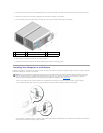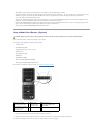
If a drive failure occurs, subsequent read and write operations are directed to the other surviving drives. A replacement drive can then be rebuilt using the
data from the surviving drives. Also, because data is duplicated on the primary and additional drives, four 120-GB RAID level 1 drives collectively have a
maximum of 360-GB on which to store data.
Configuring Your Hard Drives for RAID
Your computer can be configured for RAID, even if you did not select a RAID configuration when the computer was purchased. For an explanation of RAID levels
and their requirements, see About Your RAID Configuration. For information on how to install a hard drive, see Installing a Hard Drive.
You can use one of two methods to configure RAID hard drive volumes. The first method uses the NVIDIA MediaShield ROM utility and is performed before you
install the operating system onto the hard drive. The second method uses NVIDIA MediaShield and is performed after you have installed the operating system
and NVIDIA RAID drivers.
Both methods require that you set your computer to RAID-enabled mode before you begin.
Setting Your Computer to RAID-Enabled Mode
1. Enter system setup (see Entering System Setup).
2. Press the up- and down-arrow keys to highlight Drives, then press <Enter>.
3. Press the up- and down-arrow keys to highlight the applicable SATA drive, then press <Enter>.
4. Press the left- and right-arrow keys to highlight RAID On, and then press <Enter>. Repeat the process, as needed, for each SATA hard drive.
5. Press <Esc>, press the left- and right-arrow keys to highlight Save/Exit, and then press <Enter> to exit system setup and resume the boot process.
Using the NVIDIA MediaShield ROM Utility
Hard drives of any size may be used to create a RAID configuration. Ideally, however, the drives should be of equal size to avoid unallocated or unused space.
For an explanation of RAID levels and their requirements, see About Your RAID Configuration. For information on how to install a hard drive, see Installing a
Hard Drive.
1. Enable RAID for each applicable hard drive on your computer (see Setting Your Computer to RAID- Enabled Mode).
2. Restart the computer.
3. Press <Ctrl><N> when prompted to enter the RAID BIOS.
The Define a New Array window appears.
4. Press <Tab> to navigate to the RAID Mode field.
To create a RAID 0 configuration, use the arrow keys to select Striping.
NOTE: For more information about RAID options, see System Setup Options.
NOTICE: The following procedure will result in the loss of all data on your hard drive(s). Back up any data you want to keep before continuing.
NOTE: Do not use the following procedure to migrate an existing RAID configuration (see Converting From One RAID Configuration to Another RAID
Configuration.
NOTE: If the operating system logo appears, continue to wait until you see the Microsoft Windows desktop, then shut down your computer and
try again.


















